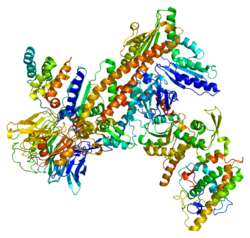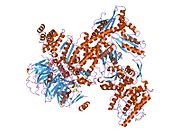Mammalian protein found in Homo sapiens
ACTR3 Available structures PDB Ortholog search: PDBe RCSB List of PDB id codes 2P9N , 1TYQ , 1U2V , 4JD2 , 3DXK , 3UKU , 3UKR , 2P9P , 2P9K , 2P9U , 3ULE , 3RSE , 2P9S , 2P9I , 4XF2 , 2P9L , 1K8K , 3DXM , 4XEI
Identifiers Aliases ACTR3 External IDs OMIM : 604222 ; MGI : 1921367 ; HomoloGene : 68483 ; GeneCards : ACTR3 ; OMA :ACTR3 - orthologs Wikidata
Actin-related protein 3 is a protein that in humans is encoded by the ACTR3 gene .[ 5]
Function
The specific function of this gene has not yet been determined; however, the protein it encodes is known to be a major constituent of the ARP2/3 complex. This complex is located at the cell surface and is essential to cell shape and motility through lamellipodial actin assembly and protrusion.[ 6]
Interactions
ACTR3 has been shown to interact with Cortactin .[ 7] [ 8]
References
^ a b c GRCh38: Ensembl release 89: ENSG00000115091 – Ensembl , May 2017^ a b c GRCm38: Ensembl release 89: ENSMUSG00000026341 – Ensembl , May 2017^ "Human PubMed Reference:" . National Center for Biotechnology Information, U.S. National Library of Medicine .^ "Mouse PubMed Reference:" . National Center for Biotechnology Information, U.S. National Library of Medicine .^ Welch MD, DePace AH, Verma S, Iwamatsu A, Mitchison TJ (Jul 1997). "The human Arp2/3 complex is composed of evolutionarily conserved subunits and is localized to cellular regions of dynamic actin filament assembly" . The Journal of Cell Biology . 138 (2): 375– 84. doi :10.1083/jcb.138.2.375 . PMC 2138188 PMID 9230079 . ^ "Entrez Gene: ACTR3 ARP3 actin-related protein 3 homolog (yeast)" .^ Weed SA, Karginov AV, Schafer DA, Weaver AM, Kinley AW, Cooper JA, Parsons JT (Oct 2000). "Cortactin localization to sites of actin assembly in lamellipodia requires interactions with F-actin and the Arp2/3 complex" . The Journal of Cell Biology . 151 (1): 29– 40. doi :10.1083/jcb.151.1.29 . PMC 2189811 PMID 11018051 . ^ Di Ciano C, Nie Z, Szászi K, Lewis A, Uruno T, Zhan X, Rotstein OD, Mak A, Kapus A (Sep 2002). "Osmotic stress-induced remodeling of the cortical cytoskeleton". American Journal of Physiology. Cell Physiology . 283 (3): C850–65. doi :10.1152/ajpcell.00018.2002 . PMID 12176742 .
Further reading
Welch MD, Iwamatsu A, Mitchison TJ (Jan 1997). "Actin polymerization is induced by Arp2/3 protein complex at the surface of Listeria monocytogenes". Nature . 385 (6613): 265– 9. Bibcode :1997Natur.385..265W . doi :10.1038/385265a0 . PMID 9000076 . S2CID 4358529 . Winter D, Podtelejnikov AV, Mann M, Li R (Jul 1997). "The complex containing actin-related proteins Arp2 and Arp3 is required for the motility and integrity of yeast actin patches" . Current Biology . 7 (7): 519– 29. doi :10.1016/S0960-9822(06)00223-5 PMID 9210376 . S2CID 52837402 . Machesky LM, Reeves E, Wientjes F, Mattheyse FJ, Grogan A, Totty NF, Burlingame AL, Hsuan JJ, Segal AW (Nov 1997). "Mammalian actin-related protein 2/3 complex localizes to regions of lamellipodial protrusion and is composed of evolutionarily conserved proteins" . The Biochemical Journal . 328 (1): 105– 12. doi :10.1042/bj3280105 . PMC 1218893 PMID 9359840 . Ma L, Rohatgi R, Kirschner MW (Dec 1998). "The Arp2/3 complex mediates actin polymerization induced by the small GTP-binding protein Cdc42" . Proceedings of the National Academy of Sciences of the United States of America . 95 (26): 15362– 7. Bibcode :1998PNAS...9515362M . doi :10.1073/pnas.95.26.15362 PMC 28048 PMID 9860974 . Machesky LM, Insall RH (1999). "Scar1 and the related Wiskott-Aldrich syndrome protein, WASP, regulate the actin cytoskeleton through the Arp2/3 complex" . Current Biology . 8 (25): 1347– 56. doi :10.1016/S0960-9822(98)00015-3 PMID 9889097 . S2CID 16661755 . Suetsugu S, Miki H, Takenawa T (Jun 1999). "Identification of two human WAVE/SCAR homologues as general actin regulatory molecules which associate with the Arp2/3 complex". Biochemical and Biophysical Research Communications . 260 (1): 296– 302. doi :10.1006/bbrc.1999.0894 . PMID 10381382 . May RC, Hall ME, Higgs HN, Pollard TD, Chakraborty T, Wehland J, Machesky LM, Sechi AS (Jul 1999). "The Arp2/3 complex is essential for the actin-based motility of Listeria monocytogenes" . Current Biology . 9 (14): 759– 62. doi :10.1016/S0960-9822(99)80337-6 PMID 10421578 . S2CID 17030983 . Loisel TP, Boujemaa R, Pantaloni D, Carlier MF (Oct 1999). "Reconstitution of actin-based motility of Listeria and Shigella using pure proteins". Nature . 401 (6753): 613– 6. Bibcode :1999Natur.401..613L . doi :10.1038/44183 . PMID 10524632 . S2CID 4313372 . Higgs HN, Blanchoin L, Pollard TD (Nov 1999). "Influence of the C terminus of Wiskott-Aldrich syndrome protein (WASp) and the Arp2/3 complex on actin polymerization". Biochemistry . 38 (46): 15212– 22. doi :10.1021/bi991843 . PMID 10563804 . Carlier MF, Nioche P, Broutin-L'Hermite I, Boujemaa R, Le Clainche C, Egile C, Garbay C, Ducruix A, Sansonetti P, Pantaloni D (Jul 2000). "GRB2 links signaling to actin assembly by enhancing interaction of neural Wiskott-Aldrich syndrome protein (N-WASp) with actin-related protein (ARP2/3) complex" . The Journal of Biological Chemistry . 275 (29): 21946– 52. doi :10.1074/jbc.M000687200 PMID 10781580 . Jay P, Bergé-Lefranc JL, Massacrier A, Roessler E, Wallis D, Muenke M, Gastaldi M, Taviaux S, Cau P, Berta P (May 2000). "ARP3beta, the gene encoding a new human actin-related protein, is alternatively spliced and predominantly expressed in brain neuronal cells" . European Journal of Biochemistry . 267 (10): 2921– 8. doi :10.1046/j.1432-1327.2000.01306.x PMID 10806390 . Weed SA, Karginov AV, Schafer DA, Weaver AM, Kinley AW, Cooper JA, Parsons JT (Oct 2000). "Cortactin localization to sites of actin assembly in lamellipodia requires interactions with F-actin and the Arp2/3 complex" . The Journal of Cell Biology . 151 (1): 29– 40. doi :10.1083/jcb.151.1.29 . PMC 2189811 PMID 11018051 . Prehoda KE, Scott JA, Mullins RD, Lim WA (Oct 2000). "Integration of multiple signals through cooperative regulation of the N-WASP-Arp2/3 complex". Science . 290 (5492): 801– 6. Bibcode :2000Sci...290..801P . doi :10.1126/science.290.5492.801 . PMID 11052943 . Marchand JB, Kaiser DA, Pollard TD, Higgs HN (Jan 2001). "Interaction of WASP/Scar proteins with actin and vertebrate Arp2/3 complex". Nature Cell Biology . 3 (1): 76– 82. doi :10.1038/35050590 . PMID 11146629 . S2CID 30437883 . Zhao X, Yang Z, Qian M, Zhu X (Jan 2001). "Interactions among subunits of human Arp2/3 complex: p20-Arc as the hub". Biochemical and Biophysical Research Communications . 280 (2): 513– 7. doi :10.1006/bbrc.2000.4151 . PMID 11162547 . Robinson RC, Turbedsky K, Kaiser DA, Marchand JB, Higgs HN, Choe S, Pollard TD (Nov 2001). "Crystal structure of Arp2/3 complex". Science . 294 (5547): 1679– 84. Bibcode :2001Sci...294.1679R . doi :10.1126/science.1066333 . PMID 11721045 . S2CID 18088124 . Gournier H, Goley ED, Niederstrasser H, Trinh T, Welch MD (Nov 2001). "Reconstitution of human Arp2/3 complex reveals critical roles of individual subunits in complex structure and activity" . Molecular Cell . 8 (5): 1041– 52. doi :10.1016/S1097-2765(01)00393-8 PMID 11741539 . Andersen JS, Lyon CE, Fox AH, Leung AK, Lam YW, Steen H, Mann M, Lamond AI (Jan 2002). "Directed proteomic analysis of the human nucleolus" . Current Biology . 12 (1): 1– 11. doi :10.1016/S0960-9822(01)00650-9 PMID 11790298 . S2CID 14132033 . Kovacs EM, Goodwin M, Ali RG, Paterson AD, Yap AS (Mar 2002). "Cadherin-directed actin assembly: E-cadherin physically associates with the Arp2/3 complex to direct actin assembly in nascent adhesive contacts" . Current Biology . 12 (5): 379– 82. doi :10.1016/S0960-9822(02)00661-9 PMID 11882288 . S2CID 9852766 .
External links
PDB gallery
1k8k : Crystal Structure of Arp2/3 Complex
1tyq : Crystal structure of Arp2/3 complex with bound ATP and calcium
1u2v : Crystal structure of Arp2/3 complex with bound ADP and calcium
2p9i : Crystal Structure of bovine Arp2/3 Complex co-crystallized with ADP and crosslinked with gluteraldehyde
2p9k : Crystal structure of bovine Arp2/3 complex co-crystallized with ATP and crosslinked with glutaraldehyde
2p9l : Crystal Structure of bovine Arp2/3 complex
2p9n : Crystal Structure of bovine Arp2/3 complex co-crystallized with ADP
2p9p : Crystal Structure of bovine Arp2/3 complex co-crystallized with ADP
2p9s : Structure of bovine Arp2/3 complex co-crystallized with ATP/Mg2+
2p9u : Crystal structure of bovine Arp2/3 complex co-crystallized with AMP-PNP and calcium

















